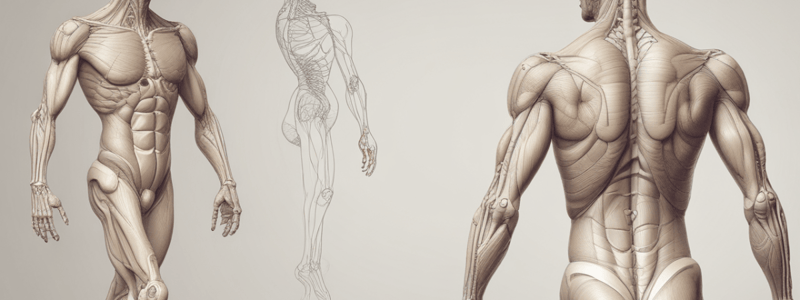Podcast
Questions and Answers
What does the AROM assessment provide information about?
What does the AROM assessment provide information about?
- only coordination and motivation
- only articular surfaces
- only muscles, nerves, and tendons
- articular surfaces, muscles, nerves, tendons, and coordination (correct)
What happens if pain appears during the AROM assessment?
What happens if pain appears during the AROM assessment?
- It can indicate a problem with contraction, stretching, or pinching (correct)
- It indicates a problem with coordination
- It indicates a problem with contractile components only
- It indicates a problem with non-contractile components only
What is the difference between AROM and PROM?
What is the difference between AROM and PROM?
- AROM relies on force and coordination while PROM does not (correct)
- PROM only assesses articular surfaces while AROM assesses all components
- AROM is passive while PROM is active
- PROM is slightly greater than AROM
What is one of the factors that influence the range of motion?
What is one of the factors that influence the range of motion?
How does gender affect the range of motion?
How does gender affect the range of motion?
How does age affect the range of motion in children?
How does age affect the range of motion in children?
What is the effect of sclerosis on the range of motion?
What is the effect of sclerosis on the range of motion?
What is the main difference between contractile and non-contractile components?
What is the main difference between contractile and non-contractile components?
What is the primary purpose of a goniometer in physical assessment?
What is the primary purpose of a goniometer in physical assessment?
What is essential for the examiner to know before performing goniometry?
What is essential for the examiner to know before performing goniometry?
What type of goniometry is used to measure movements?
What type of goniometry is used to measure movements?
What is a precaution to take when using a compass with an inclinometer?
What is a precaution to take when using a compass with an inclinometer?
What is the purpose of a visual inspection of the movement?
What is the purpose of a visual inspection of the movement?
What type of goniometer is used in research and requires accurate calibrations and subject positioning?
What type of goniometer is used in research and requires accurate calibrations and subject positioning?
What is not recommended when using an inclinometer?
What is not recommended when using an inclinometer?
What is the purpose of establishing a logical sequence in goniometry?
What is the purpose of establishing a logical sequence in goniometry?
What is the correct placement of the proximal-fixed arm during goniometer alignment?
What is the correct placement of the proximal-fixed arm during goniometer alignment?
Why is visual estimation important during goniometer alignment?
Why is visual estimation important during goniometer alignment?
What is the purpose of the fulcrum in a goniometer?
What is the purpose of the fulcrum in a goniometer?
What is the correct notation for recording goniometer measurements?
What is the correct notation for recording goniometer measurements?
What is the functional angle in goniometer measurement?
What is the functional angle in goniometer measurement?
What is the purpose of contours outlining in goniometer measurement?
What is the purpose of contours outlining in goniometer measurement?
What is the correct way to perform bilateral measurements using a goniometer?
What is the correct way to perform bilateral measurements using a goniometer?
What is the purpose of a measuring tape and ruler in goniometry?
What is the purpose of a measuring tape and ruler in goniometry?
Flashcards are hidden until you start studying
Study Notes
Goniometer Alignment and Placement
- Consists of potentiometer, fixed arm, and mobile arm
- Bony references must be precisely located for accurate alignment
- Proximal (fixed) arm: parallel to longitudinal axis of proximal segment
- Distal (mobile) arm: parallel to longitudinal axis of distal segment
- Fulcrum placement: on the movement axis of the assessed joint
Measurement and Recording
- Results recorded in X/0/Y system:
- X: Flexion, Abduction, External Rotation, Supination
- 0: Neutral position (reference)
- Y: Extension, Adduction, Internal Rotation, Pronation
- Effective angle: possible range of motion (angle) in each measurement
- Functional angle: minimum range of motion (angle) required for joint functioning
Other Measurement Devices
- Measuring Tape and Ruler: measures distances and perimeters, requires bony or cutaneous references
- Contours outlining: for measuring small joints
Joint Mobility Assessment (JMA)
- AROM (Active Range of Movement): provides information about articular surfaces, muscles, nerves, tendons, and coordination
- PROM (Passive Range of Movement): slightly greater than AROM, provides information about articular surfaces
- ROM influencing factors: age, position, gender, experience, BMI, day time, physical activity habits, warm up, professional occupation, leisure activities
Goniometry
- Measurement of a corporal segment related to another through a particular joint using graded devices
- Examiner must know: subject position, required stabilisation, physiological final sensation
- Procedure: bony prominences location, appropriate alignment/posture stabilisation, device proper alignment, segment displacement and end stop, device interpretation, right data registration
Inclinometer
- Gravity-dependent device comprising angle conveyor, pendulum needle (frontal + sagittal planes), and magnetic compass (horizontal plane)
- Placed upon the distal segment
- Not recommended for small joints, deformities, and swollen areas
- Precautions to take using a compass: ask for pacemaker
Electronic Goniometer
- Used in research, appropriate for dynamic measurements
- Requires accurate calibrations and subject positioning
Studying That Suits You
Use AI to generate personalized quizzes and flashcards to suit your learning preferences.




